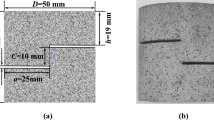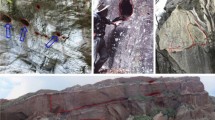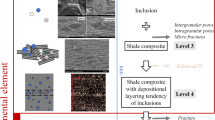Abstract
In this work, uniaxial compressive strength test combined with AE monitoring and post-test CT scanning techniques were performed to investigate the influence of interbed orientation on the mechanical properties, energy evolution and fracture pattern of anisotropic marble obtained from Lilou iron mine. The marble samples were cored along angles of 0°, 15°, 30°, 45°, 60°, and 90° with respect to the interbeds. The experimental results suggested that the interbed structure in marble have a significant influence on the geomechanical properties, AE pattern, dissipated and released energy, and crack pattern. The stress–strain behaviors present anisotropy and they show “U” shape against interbed orientation. The AE events, dissipated energy and released energy first decreases and then increases with increasing orientation, they get to the minimum for the sample with an interbed orientation of 30°. Post-test CT scanning and macroscopic fracture morphology description reveal the crack morphology and the reason of energy anisotropy. The final failure morphology is the external expression of energy dissipation and release, crack pattern is the simplest for the 30° orientation sample. The most striking founding is that it is the crack tortuosity degree not the crack number that determines the energy dissipation and release characteristics. For the sample with curved crack after failure, the released energy is much more than samples with straight cracks. The experimental results in this work prove the importance of interbed structure on the anisotropic mechanical responses and energy mechanism, fracture evolution is structure dependent.
















Similar content being viewed by others
References
Aubertin M, Gill DE, Simon R (1994) On the use of the brittleness index modified (BIM) to estimate the post-peak behavior of rocks. Aqua Fenn 23:24–25
Bagde MN, Petroš V (2009) Fatigue and dynamic energy behavior of rock subjected to cyclical loading. Int J Rock Mech Min Sci 46:200–209
Bratov V, Petrov Y (2007) Optimizing energy input for fracture by analysis of the energy required to initiate dynamic mode I crack growth. Int J Solids Struct 44(7–8):2371–2380
Chen W, Konietzky H, Tan X, Frühwirt T (2016) Pre-failure damage analysis for brittle rocks under triaxial compression. Comput Geotech 74:45–55
Chen Z, He C, Wu D, Xu G, Yang W (2017) Fracture evolution and energy mechanism of deep-buried carbonaceous slate. Acta Geotech 12(6):1243–1260
Cornetti P, Pugno N, Carpinteri A, Taylor D (2006) Finite fracture mechanics: a coupled stress and energy failure criterion. Eng Fract Mech 73(14):2021–2033
Eberhardt E, Stead D, Stimpson B, Read RS (1997) Changes in acoustic event properties with progressive fracture damage. Int J Rock Mech Min Sci 34(71):71–83
Einav I, Houlsby GT, Nguyen GD (2007) Coupled damage and plasticity models derived from energy and dissipation potentials. Int J Solids Struct 44(7–8):2487–2508
Eppes MC, Magi B, Hallet B, Delmelle E, Mackenzie-Helnwein P, Warren K, Swami S (2016) Deciphering the role of solar-induced thermal stresses in rock weathering. Geol Soc Am Bull 128(9–10):1315–1338
Ferro G (2006) On dissipated energy density in compression for concrete. Eng Fract Mech 73(11):1510–1530
Hazzard JF, Young RP (2000) Simulating acoustic emissions in bonded-particle models of rock. Int J Rock Mech Min Sci 37(5):867–872
Hazzard JF, Young RP (2002) Moment tensors and micromechanical models. Tectonophysics 356:181–197
Higo Y, Oka F, Sato T, Matsushima Y, Kimoto S (2013) Investigation of localized deformation in partially saturated sand under triaxial compression using microfocus X-ray CT with digital image correlation. Soils Found 53(2):181–198
Hua AZ, You MQ (2001) Rock failure due to energy release during unloading and application to underground rock burst control. Tunn Undergr Space Technol 16(3):241–246
Ju Y, Wang HJ, Yang YM, Hu QA, Peng RD (2010) Numerical simulation of mechanisms of deformation, failure and energy dissipation in porous rock media subjected to wave stresses. Sci China Technol Sci 53(4):1098–1113
Karpyn ZT, Alajmi A, Radaelli F, Halleck PM, Grader AS (2009) X-ray CT and hydraulic evidence for a relationship between fracture conductivity and adjacent matrix porosity. Eng Geo 103(3–4):139–145
Keller A (1998) High resolution, non-destructive measurement and characterization of fracture apertures. Int J Rock Mech Min Sci 35:1037–1050
Labiouse V, Vietor T (2014) Laboratory and in situ simulation tests of the excavation damaged zone around galleries in Opalinus Clay. Rock Mech Rock Eng 47(1):57–70
Lemaitre J, Desmorat R, Sauzay M (2000) Anisotropic damage law of evolution. Eur J Mech A Solids 19(2):187–208
Li LC, Li SH, Tang CA (2014) Fracture spacing behavior in layered rocks subjected to different driving forces: a numerical study based on fracture infilling process. Front Earth Sci 8(4):472–489
Liu XS, Ning JG, Tan YL, Gu QH (2016) Damage constitutive model based on energy dissipation for intact rock subjected to cyclic loading. Int J Rock Mech Min Sci 85:27–32
Lockner D (1993) The role of acoustic emission in the study of rock fracture. Int J Rock Mech Min Sci 30:883–899
Martin CD (1993) The strength of massive Lac du Bonnet granite around underground openings. Ph.D. thesis, University of Manitoba
Meng QB, Zhang MW, Han LJ, Pu H, Nie TY (2016) Effects of acoustic emission and energy evolution of rock specimens under the uniaxial cyclic loading and unloading compression. Rock Mech Rock Eng 49(10):3873–3886
Meng Q, Zhang M, Zhang Z, Han L, Pu H (2018) Experimental research on rock energy evolution under uniaxial cyclic loading and unloading compression. Geotech Test J 41(4):717–729
Nawrocki PA, Dusseault MB (1995) Modelling of damaged zones around openings using radius-dependent Young’s modulus. Rock Mech Rock Eng 28(4):227–239. https://doi.org/10.1007/BF01020228
Peng RD, Ju Y, Wang JG, **e H, Gao F, Mao L (2015) Energy dissipation and release during coal failure under conventional triaxial compression. Rock Mech Rock Eng 48(2):509–526
Pestman BJ, Munster JGV (1996) An acoustic emission study of damage development and stress-memory effects in sandstone. Int J Rock Mech Min Sci 33(6):585–593
Sanchidrian JA, Segarra P, Lopez LM (2007) Energy components in rock blasting. Int J Rock Mech Min 44(1):130–147
Song Z, Frühwirt T, Konietzky H (2018) Characteristics of dissipated energy of concrete subjected to cyclic loading. Constr Build Mater 168:47–60
Wang JA, Park HD (2001) Comprehensive prediction of rock burst based on analysis of strain energy in rocks. Tunn Undergr Space Technol 16(1):49–57
Wang X, Pan Y, Zhang Z (2013) A spatial strain localization mechanism of zonal disintegration through numerical simulation. J Min Sci 49(3):357–367
Wang Y, Li CH, Hu YZ (2018) Experimental investigation on the fracture behavior of black shale by acoustic emission monitoring and CT image analysis during uniaxial compression. Geophys J Int. https://doi.org/10.1093/gji/ggy011
William FH (2013) Solid mechanics. Cambridge University Press, Cambridge
**e HP, Ju Y, Li LY (2005) Criteria for strength and structural failure of rocks based on energy dissipation and energy release principles. Chin J Rock Mech Eng 24(17):3003–3010 (in Chinese)
**e HP, Li L, Peng R, Ju Y (2009) Energy analysis and criteria for structural failure of rocks. J Rock Mech Geotech Eng 1(1):11–20
**e HP, Li LY, Ju Y, Peng RD, Yang YM (2011) Energy analysis for damage and catastrophic failure of rocks. Sci China Technol Sci 54(Suppl. S1):199–209
You MQ, Su CD, Xu T (2001) Loading or unloading process in axial direction and Young’s modulus of rock specimen. Chin J Geotech Eng 23(05):588
Zhao J, Sheng D, Zhou W (2005) Shear banding analysis of geomaterials by strain gradient enhanced damage model. Int J Solids Struct 42(20):5335–5355
Zhao X, Cai M, Wang J, Ma L (2013) Damage stress and acoustic emission characteristics of the Beishan granite. Int J Rock Mech Min Sci 64:258–269
Zhou XP, Qian QH, Yang HQ (2010) Effect of loading rate on fracture characteristics of rock. J Cent South Univ Technol 17(1):150–155
Acknowledgements
The authors would like to thank the editors and the anonymous reviewers for their helpful and constructive comments. This study was supported by National key technologies Research and Development program (2018YFC0808402, 2018YFC0604601), the State Key Laboratory for GeoMechanics and Deep Underground Engineering, China University of Mining and Technology (SKLGDUEK1824), and the Fundamental Research Funds for the Central Universities (2302017FRF-TP-17-027A1).
Author information
Authors and Affiliations
Corresponding author
Additional information
Publisher's Note
Springer Nature remains neutral with regard to jurisdictional claims in published maps and institutional affiliations.
Rights and permissions
About this article
Cite this article
Wang, Y., Tan, W.H., Liu, D.Q. et al. On Anisotropic Fracture Evolution and Energy Mechanism During Marble Failure Under Uniaxial Deformation. Rock Mech Rock Eng 52, 3567–3583 (2019). https://doi.org/10.1007/s00603-019-01829-1
Received:
Accepted:
Published:
Issue Date:
DOI: https://doi.org/10.1007/s00603-019-01829-1




